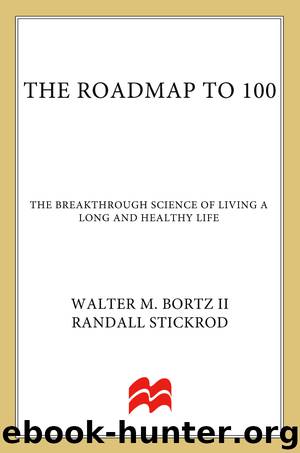The Roadmap to 100 by Walter M. Bortz II MD

Author:Walter M. Bortz, II, MD
Language: eng
Format: epub
Publisher: St. Martin's Press
Published: 2010-05-19T16:00:00+00:00
CHAPTER 6
ENGAGEMENT: THE NECESSITY OF BEING NECESSARY
The probability of living to 100 and retaining your self-efficacy all the while is astonishingly good, as we have seen, if you embrace a life of movement. That is, if you systematically maintain your aerobic fitness and consciously strive to maintain sufficient lean muscle mass. The evidence is almost overwhelming. And yet we know, as sentient beings, that there is more to living than merely managing our metabolic needs.
There is an intangible factor that defies quantification but is a crucial part of who we are and how we live. Mme. Calment, who lived to 122 years, famously declared that she had “a great passion for living.” Without reasons to live, one might ask, why bother? The character of our will to live is one of the things that distinguishes us as unique beings, a hallmark of our individuality.
A variety of studies of centenarians has concluded that, aside from physical health, the intangible characteristics that stand out the most are optimism, hope, the ability to cope with loss, and engagement. Engagement is the expression of purpose. It is in our nature to seek purpose in our existence. We feel that engagement underlies all the other intangible factors; it allows us to find joy in living as long as possible.
We learn much from witnessing the absence of engagement. At one extreme, we know that sensory deprivation is lethal. The stimulation of ordinary daily experience is essential to our equilibrium. People who live in isolation rarely thrive. As we go through life, each of us has a “social convoy” of friends, family, and associates that accompanies us. In later years, many simply allow that convoy to vanish by attrition, taking with it a good part of the energy milieu that supports us. In studies of the social, emotional, and cognitive processes that accompany aging, Dr. Laura Carstensen of Stanford University has repeatedly found that once someone begins to consciously anticipate death, they tend to disengage.
Engagement comes in many flavors. Essentially it means a motivated involvement with factors outside oneself. It can be a spouse or mate. It can be family. It can be friends or community involvement. More often in present times it is work or career. Sometimes it is a creative pursuit. Occasionally it is a combination of these.
Every centenarian has a story. There are often great variations in lifestyle, in diet, in the kinds of activities each engaged in, not to mention their socioeconomic circumstances. But the one thing that virtually all have had is a clear and often compelling sense of engagement. Therein lies not just a central part of the practical longevity formula, but a richness of human experience that is the foundation of our humanity.
Nearly all centenarians have many meaningful interpersonal relationships. They are almost never loners, and examples abound. For instance, one of the subjects of the New England Centenarian Study, William Cohen, 101 at last report, viewed independence as important to his longevity, but realized that a close family was just as important.
Download
This site does not store any files on its server. We only index and link to content provided by other sites. Please contact the content providers to delete copyright contents if any and email us, we'll remove relevant links or contents immediately.
| Anatomy | Animals |
| Bacteriology | Biochemistry |
| Bioelectricity | Bioinformatics |
| Biology | Biophysics |
| Biotechnology | Botany |
| Ecology | Genetics |
| Paleontology | Plants |
| Taxonomic Classification | Zoology |
Sapiens: A Brief History of Humankind by Yuval Noah Harari(13957)
The Tidewater Tales by John Barth(12383)
Mastermind: How to Think Like Sherlock Holmes by Maria Konnikova(6915)
Do No Harm Stories of Life, Death and Brain Surgery by Henry Marsh(6674)
The Thirst by Nesbo Jo(6422)
Why We Sleep: Unlocking the Power of Sleep and Dreams by Matthew Walker(6328)
Life 3.0: Being Human in the Age of Artificial Intelligence by Tegmark Max(5167)
Sapiens by Yuval Noah Harari(5110)
The Longevity Diet by Valter Longo(4848)
The Body: A Guide for Occupants by Bill Bryson(4560)
The Rules Do Not Apply by Ariel Levy(4506)
The Immortal Life of Henrietta Lacks by Rebecca Skloot(4238)
Why We Sleep by Matthew Walker(4187)
Animal Frequency by Melissa Alvarez(4141)
Yoga Anatomy by Kaminoff Leslie(4096)
The Hacking of the American Mind by Robert H. Lustig(4069)
All Creatures Great and Small by James Herriot(3971)
Barron's AP Biology by Goldberg M.S. Deborah T(3933)
Double Down (Diary of a Wimpy Kid Book 11) by Jeff Kinney(3904)
